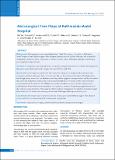Please use this identifier to cite or link to this item:
https://hdl.handle.net/20.500.14356/1810Full metadata record
| DC Field | Value | Language |
|---|---|---|
| dc.contributor.author | Rai, S M | - |
| dc.contributor.author | Grinswll, D | - |
| dc.contributor.author | Smith, D Hunter | - |
| dc.contributor.author | Corlett, R | - |
| dc.contributor.author | Nakarmi, K | - |
| dc.contributor.author | Basnet, S J | - |
| dc.contributor.author | Shakya, P | - |
| dc.contributor.author | Nagarkoti, K | - |
| dc.contributor.author | Ghartimagar, M | - |
| dc.contributor.author | Karki, B | - |
| dc.date.accessioned | 2023-05-23T09:33:17Z | - |
| dc.date.available | 2023-05-23T09:33:17Z | - |
| dc.date.issued | 2014 | - |
| dc.identifier.citation | RaiS. M., GrinswllD., Hunter-SmithD., CorlettR., NakarmiK., BasnetS. J., ShakyaP., NagarkotiK., GhartimagarM., & KarkiB. (2014). Microsurgical Free Flaps at Kathmandu Model Hospital. Journal of Nepal Health Research Council. https://doi.org/10.33314/jnhrc.v0i0.497 | en_US |
| dc.identifier.issn | Print ISSN: 1727-5482; Online ISSN: 1999-6217 | - |
| dc.identifier.uri | http://103.69.126.140:8080/handle/20.500.14356/1810 | - |
| dc.description | Original Article | en_US |
| dc.description.abstract | Abstract  Background: Microsurgery is an emerging subspecialty in Nepal. Microsurgery was started at Kathmandu Model Hospital in 2007 with the support from Interplast Australia and New Zealand. This study will be useful for establishing a baseline for future comparisons of outcome variables and for defining the challenges of performing microsurgical free flaps in Nepal.  Methods: A retrospective cross sectional study was conducted using the clinical records of all the microsurgical free flaps performed at Kathmandu Model Hospital from April 2007 to April 2014.  Results: Fifty-six free flaps were performed. The commonest indication was neoplasm followed by post-burn contracture, infection and trauma. Radial artery forearm flap was the commonest flap followed by fibula, anterolateral thigh, rectus, tensor facia lata, lattisimus dorsi, deep inferior epigastric artery perforator, and deep circumflex iliac artery flap. Radial artery forearm flaps and anterolateral thigh flaps were mostly used for burn contracture reconstructions. Twelve of the 13 (92%) fibulae were used for mandibular reconstruction for oral cancer and ameloblastoma. Rectus flaps were used mainly for covering defects over tibia. Hospital stay ranged from six to 67 days with an average of fourteen. Fifteen patients (26%) developed complications. The duration of operation ranged from six hours to 10.5 hours with an average of nine hours. The longest follow up was for four years.  Conclusions: Microsurgery can be started even in very resource-poor center if there is support from advanced centers and if there is commitment of the institution and surgical team.  Keywords: complication; developing countries; free flap; indication; Interplast; microsurgery | en_US |
| dc.language.iso | en | en_US |
| dc.publisher | Nepal Health Research Council | en_US |
| dc.relation.ispartofseries | May-Aug, 2014;497 | - |
| dc.subject | Complications | en_US |
| dc.subject | Developing countries | en_US |
| dc.subject | Free flap | en_US |
| dc.subject | Indication | en_US |
| dc.subject | Interplast | en_US |
| dc.subject | Microsurgery | en_US |
| dc.title | Microsurgical Free Flaps at Kathmandu Model Hospital | en_US |
| dc.type | Journal Article | en_US |
| local.journal.category | Original Article | - |
| Appears in Collections: | Vol. 12 No. 2 Issue 27, May - Aug 2014 | |
Files in This Item:
| File | Description | Size | Format | |
|---|---|---|---|---|
| 497-Article Text-864-1-10-20150204.pdf | Fulltext Download | 553.28 kB | Adobe PDF |  View/Open |
Items in DSpace are protected by copyright, with all rights reserved, unless otherwise indicated.
